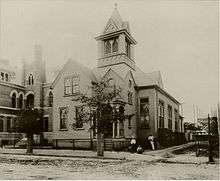St. Andrews School (Virginia)
Coordinates: 37°32′32″N 77°27′09″W / 37.5422°N 77.4526°W
| St. Andrew's School (Virginia) | |
|---|---|
| Address | |
|
227 South Cherry Street Richmond, Virginia United States | |
| Information | |
| Type | Tuition-free Private school (Non-profit Organization) |
| Motto |
Gracefully enriching lives through tuition-free education |
| Established | 1894 |
| Head of school | Dr. Cyndy Weldon-Lassiter |
| Grades | K–5 |
| Enrollment | 96 |
| Color(s) |
Red, White, Black |
| Mascot | Otter |
| Newspaper | Grace Notes |
| Affiliation | Episcopalian |
| Website | Official website |
St. Andrew's School is an independent elementary school in Richmond, Virginia, specifically for families with low incomes. It is fully accredited by the Virginia Association of Independent Schools (VAIS). Noted Richmond philanthropist and social reformer Grace Arents founded the school in 1894. It is located in the historic Oregon Hill neighborhood. The school includes grades K-5 with a total of 96 students.


History
Grace Arents
Grace Arents was born in New York City but spent most of her life establishing philanthropic institutions in Richmond, VA. Arents came under the care of her uncle and wealthy tobacco investor, Major Lewis Ginter, after her father's death.[1] Arents eventually inherited her uncle's fortune and used the money to create and support in perpetuity a number of social institutions. She focused many of her efforts in the working class neighborhood of Oregon Hill. The construction of St. Andrew's Houses in 1904, "which constitute one of the earliest examples of subsidized housing in Virginia,"[2] demonstrate her forward thinking approach.
In addition to creating St. Andrew's School, Arents funded and supervised the construction of the buildings in the St. Andrew's Church Complex, which are on the Virginia Register of Historic Places.[3] She opened her estate at Bloemendaal to children recovering from illnesses, and her provisions for its continuance ultimately led to the founding of Lewis Ginter Botanical Garden.[4] A historical marker sponsored by St. Andrew's School commemorates Arents's contributions to the citizens of Richmond:
“Grace Evelyn Arents worked tirelessly as an urban reformer and philanthropist to improve the daily life of individuals regardless of race, gender, or class. She developed a church complex that included St. Andrew’s Episcopal Church, St. Andrew’s School, the Grace Arents Free Library, a teachers’ house, and a medical clinic. Arents also established a night school for working children, built public baths and playgrounds, and funded numerous social programs. She supported the formation of the Instructive Visiting Nurse Association. Her legacy continues in the activities of St. Andrew’s Church, St. Andrew’s School, and the William Byrd Community House in Oregon Hill.”[5]
Early Years of the School
Arents created an environment in which poor and working class children could receive a quality education. Her teaching philosophy, which addressed the multiple needs of the children in her care, remains an integral part of the school today.[6] Arents's program focused on both academics and physical education.[7] She also provided meals for students who spent the day working in factories such as the Tredegar Iron Works.[8]
Academics
St. Andrew's provides education to children from low-income families and awards a full scholarship to each student.[9] The school includes grades K through 5 with class sizes of 16 students or fewer. Parents, teachers, staff, volunteers, and donors support the school's daily operations.
St. Andrew's School adheres to the whole child approach to education, which posits that "each child, in each school, in each of our communities deserves to be healthy, safe, engaged, supported, and challenged."[10] According to this philosophy, the physical and emotional health of students, as well as the development of stable, safe social relationships, is as much a part of an effective education process as academics. Family programming, which situates students and their learning within their larger social context, is a further element of the whole child approach to which St. Andrew's adheres. The head of school visits incoming kindergarteners at home in order to establish a relationship between families and the school.[11] The school provides nutritious meals, such as breakfast, lunch, and snacks, to students on school days. Through the implementation of Social Emotional Learning (SEL), students work on emotional skills and learn to resolve conflicts productively.
Academics at St. Andrew's include a focus on reading, writing, social studies, and STEAM - science, technology, engineering, art/design, and math. Through STEAM, students explore the interconnections between disciplines.[12] The curriculum includes a physical education component. The school remains affiliated with the Episcopal Church, and students attend chapel.
References
- ↑ Kollatz, Harry Jr. (May 5, 2009). “The Invisible Philanthropist.” Richmond Magazine. http://www.richmondmagazine.com/articles/the-invisible-philanthropist-05-05-2009.html
- ↑ “Oregon Hill Historic District.” National Park Service U.S. Department of the Interior. http://www.nps.gov/nr/travel/richmond/OregonHillHD.html
- ↑ (June 22, 1979). “National Register of Historic Places Inventory — Nomination Form.” Virginia Department of Historic Resources. http://www.dhr.virginia.gov/registers/Cities/Richmond/127-0314_St_Andrew's_Episcopal_Church_Complex_1979_Final_Nomination.pdf
- ↑ Kollatz, Harry Jr. (May 5, 2009). “The Invisible Philanthropist.” Richmond Magazine. http://www.richmondmagazine.com/articles/the-invisible-philanthropist-05-05-2009.html
- ↑ (April 15, 2009). “Ten New State Historical Highway Markers Approved.” Virginia Department of Historic Resources. http://www.dhr.virginia.gov/contents/post%20march.2009.bd.meeting.marker.release.1x.pdf
- ↑ “History.” St. Andrew’s School. http://www.st-andrews-school.org/index.php/our-school/history/
- ↑ Kollatz, Harry Jr. (May 5, 2009). “The Invisible Philanthropist.” Richmond Magazine. http://www.richmondmagazine.com/articles/the-invisible-philanthropist-05-05-2009.html
- ↑ Kollatz, Harry Jr. (May 5, 2009). “The Invisible Philanthropist.” Richmond Magazine. http://www.richmondmagazine.com/articles/the-invisible-philanthropist-05-05-2009.html
- ↑ “Mission.” St. Andrew’s School. http://www.st-andrews-school.org/index.php/our-school/mission/
- ↑ "The Whole Child Approach" (2014) http://www.wholechildeducation.org
- ↑ Scott, Tracy (March 2011) "St. Andrew's School Gracefully Enriching Lives Through Tuition-Free Education" http://richmondfamilymagazine.com/article/st-andrews-school/ Richmond Family Magazine
- ↑ "About" STEAM Education http://www.steamedu.com/html/steam-_about.html